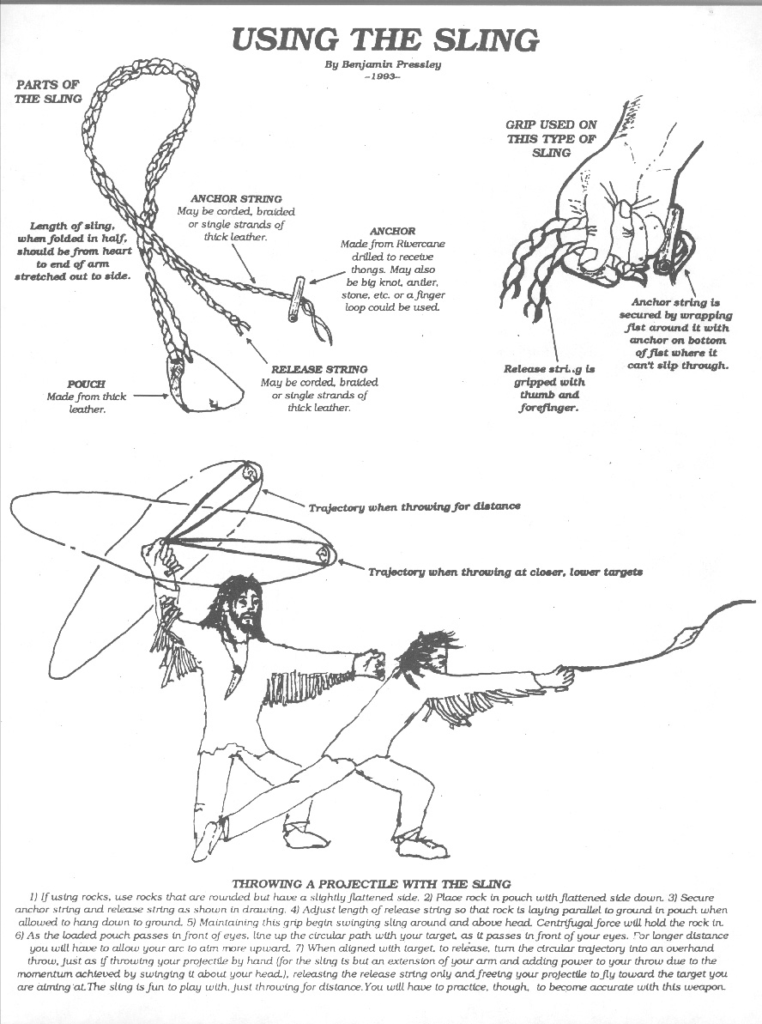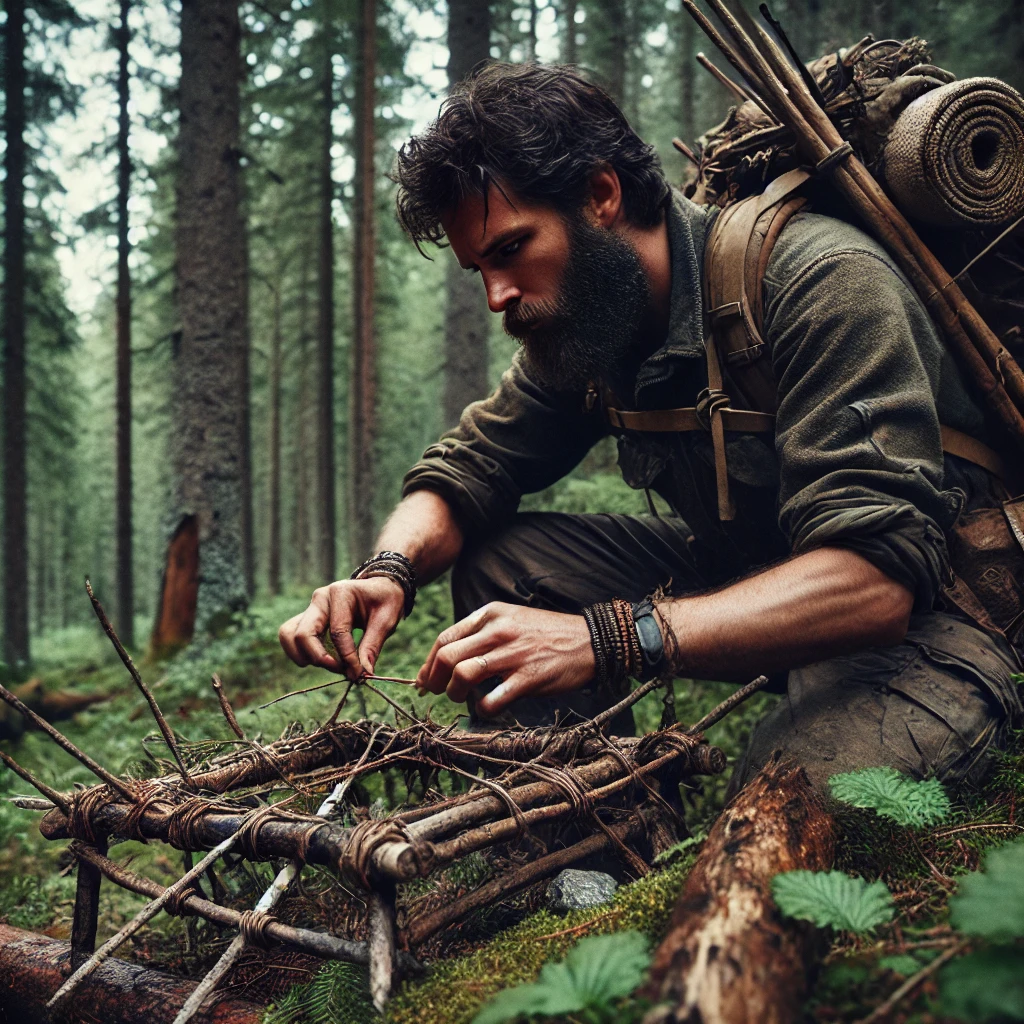From David vs Goliath and beyond The Role of the Sling in Warfare and Hunting
The Shepard’s Sling – The sling is one of humanity’s oldest projectile weapons, used for hunting and warfare across countless cultures. Simple yet effective, it consists of a pouch and cords that, when swung with skill, can launch stones or lead bullets at high speeds. This guide explores the sling’s origins, traditional construction methods, effective usage techniques, and historical significance.
1. Historical Context of the Shepard’s Sling
The sling dates back to at least the Neolithic period (10,000–4,500 BCE), with evidence found in Egyptian, Greek, Roman, and Mesoamerican cultures. Notable historical uses include:
- Biblical Story of David and Goliath – David’s victory over the giant with a sling (1 Samuel 17) highlights its effectiveness.
- Roman and Greek Warfare – Slingers (funditores in Latin) were specialized troops, using lead bullets (glandes) with inscriptions.
- Incan Warriors – Used slings in battles against Spanish conquistadors.
- Balearic Slingers – Mercenaries from the Balearic Islands renowned for their accuracy.
The sling remained in use until the widespread adoption of gunpowder but is still employed today in traditional hunting and sports.
2. Traditional Materials Used for Making a Shepard’s Sling
Slings were crafted from locally available materials, including:
- Cords: Leather strips, plant fibers (flax, hemp, sisal), or woven animal sinew.
- Pouch: Leather, woven fabric, or flexible plant material.
- Projectiles: Smooth stones, clay pellets, or cast lead bullets (in advanced societies).
3. Step-by-Step Guide to Crafting a Sling
Materials Needed:
- A strip of leather or thick fabric (~4×2 inches for the pouch)
- Two lengths of cord (~24-30 inches each)
- Scissors or a knife
- Needle and thread (if stitching the pouch)
Construction Steps:
- Shape the Pouch:
- Cut a rectangular or oval piece of leather/fabric.
- Fold it slightly to create a shallow cup (this cradles the projectile).
- Attach the Cords:
- Punch or cut small holes at both ends of the pouch.
- Tie one cord securely to each end (use strong knots like the square or surgeon’s knot).
- Finish the Cords:
- Leave one cord slightly longer to form a finger loop (for retention).
- The other cord remains free for release.
- Reinforce Weak Points:
- Stitch around the pouch holes to prevent tearing.
- Optionally, braid the cords for better grip.
4. How to Use a Shepard’s Sling Effectively

Basic Throwing Technique:
- Loading:
- Place a smooth stone or bullet in the pouch.
- Hold the looped cord around your middle finger and grip the free end between thumb and forefinger.
- Swinging:
- Swing the sling in a circular motion (sidearm or overhead for distance).
- Build momentum with 2-3 rotations.
- Release:
- Let go of the free cord at the optimal point (usually when the sling is at ~45 degrees forward).
- Follow through with your arm for accuracy.
Advanced Tips:
- Accuracy: Practice with consistent release timing.
- Power: Longer slings (up to 5 ft) increase range but require more skill.
- Projectiles: Smooth, rounded stones (golf-ball size) fly best.
5. Historical and Cultural Significance
- Hunting Tool: Used for small game like birds and rabbits.
- Warfare: Cheap, long-range (up to 400m with lead bullets), and deadly in skilled hands.
- Symbolism: Associated with shepherd cultures (e.g., David) and peasant militias.
6. Safety Tips and Beginner Advice
- Start Slow: Practice in an open area away from people/animals.
- Wear Gloves: Prevents cord burns.
- Use Light Stones: Heavier projectiles require control.
- Modern Alternatives: Paracord slings are durable and easy to make.
Where to Learn More:
- Slinging.org – A community for sling enthusiasts.
- Primitive Technology YouTube – Demonstrations of traditional sling use.
The Evolution of the Shepard’s Sling
The sling is a fascinating example of early human ingenuity—simple to make yet devastating in skilled hands. Whether for historical interest, survival skills, or sport, mastering the sling connects us to an ancient tradition of projectile warfare and hunting. With practice, even beginners can achieve surprising accuracy and power.
Would you like recommendations for historical accounts or modern slinging competitions? Let me know how you’d like to explore further!
Historical and Archaeological Resources
- The Sling in Medieval Europe – An article on the sling’s role in medieval warfare.
- Ancient Greek and Roman Slings – A scholarly look at sling use in classical antiquity.
- The Balearic Slingers – Explores the famed mercenaries of the ancient Mediterranean.
Crafting and DIY Slings
- How to Make a Paracord Sling – Step-by-step guide with photos.
- Traditional Leather Sling Tutorial – Video demonstration using historical methods.
- Natural Fiber Slings (Cordage Making) – How to make slings from plant fibers.
Modern Slinging Communities & Competitions
- Slinging.org Forum – Active community for sling enthusiasts.
- World Slinging Association – Promotes slinging as a sport; hosts events.
- International Sling Festival (Mallorca) – Celebrates Balearic slinging traditions.




